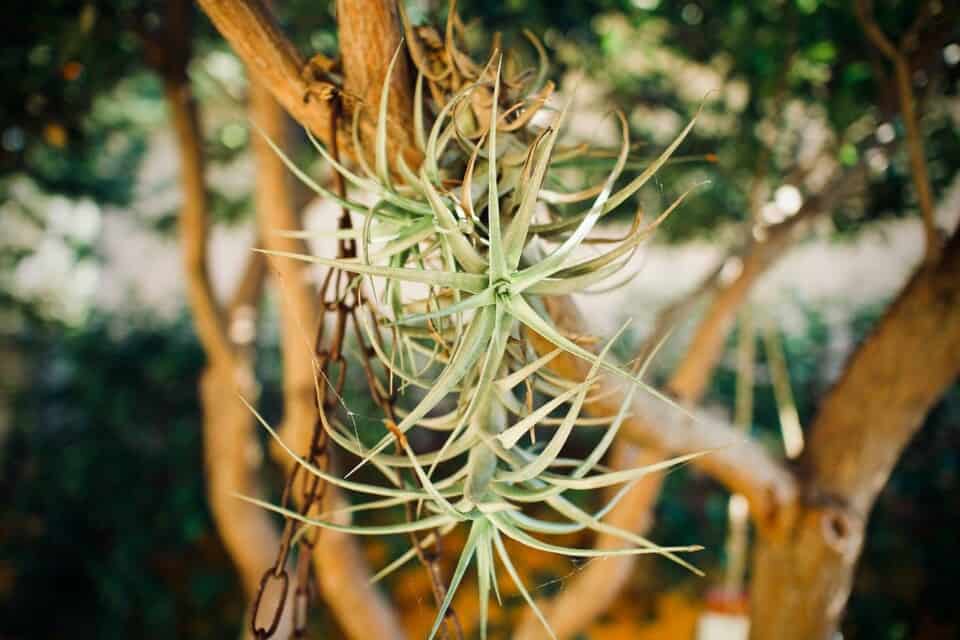Some links in the post are affiliate links and I get a commission from purchases made through some links found in the post.
Have you ever thought of ways to kill your plant? I know this might seem odd, but it’s a game I like to play. I go around my home, reviewing how I can kill each plant.
For example, I will walk up to my dragon tree and go, “If I overwater this plant, it will surely start dying. And if I do nothing about it, it will die.”
Why do I have such a routine which some people may find weird? I like to think of it as the reverse approach – I identify what I could do wrong and then do the opposite. See? There is a method to my somewhat madness.
Last weekend, I did the same thing with my air plant. And I uncovered possible problems you can encounter with your air plant and how you can solve them.
Most of the issues boiled down to plant care issues. So, I created a guide that takes you through what you might be doing wrong and how your plant can react to this.
The problems you can face when owning an air plant are: Overwatering, Underwatering, too much sun exposure, not enough sun exposure, temperature variation, inadequate air circulation, fertilization issues and pest issues.
As you read through my notes, you’ll understand this thinking even more:
Possible Problems with Your Air Plant
This section highlights some of the common questions people post online about their air plants. You may even find that you have asked a similar question at some point.
Under each question, I have noted down the possible causes, which I will detail later in the next section.
Why is My Air Plant Yellow?
- Overwatering,
- Too much sun exposure,
- Overfeeding, and
- Extreme temperature variations.
For more on this, check out article here!
Why is My Air Plant Turning Brown?
- Too much sun exposure,
- Underwatering,
- Overfertilization,
- Overwatering (and root rot), and
- Poor air circulation.
For more on this, check out article here!
Why is My Air Plant Red?
- The plant is well taken care of – yes, a change in hue could imply satisfaction!
- Too much sun exposure, or
- The plant is about to bloom.
Why is My Air Plant Turning Black?
- Root rot (overwatering),
- Mealybug infestation, or
- A fungal infection.
Why is My Air Plant Turning White?
- Trichomes (this is normal),
- Sunburn, or
- Moldy growth.
Why is My Air Plant Drooping?
- Underwatering, and
- Too much exposure to heat.
Why is My Air Plant Dying?
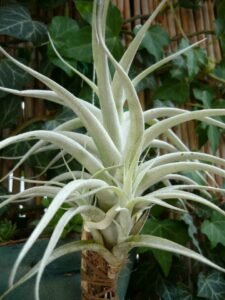 Overwatering,
Overwatering,- Underwatering,
- Overfeeding,
- Underfeeding,
- Pest infestation,
- Too much sun exposure,
- Too little sun exposure,
- Extreme temperature variation,
- Poor air circulation, or
- The natural air plant life cycle is coming to an end.
You may have noticed that some issues keep arising, e.g., watering and lighting. So, let’s uncover how you can provide your plant with what it needs without giving it too much or too little.
What Can Cause Air Plant Problems?
The air plant is unique in so many ways – the fact that it dies when it blooms, its ability to absorb water and nutrients from the air, etc.
But it’s still a plant that needs you to take good care of it, lest it dies. Sometimes, we forget this because this plant is so low maintenance. Below are some of the ways you could be slowly killing your plant without even knowing it:
1) Overwatering
Air plants prefer light watering. If you give them more water than necessary, the roots start drowning in it, creating a favorable environment for fungal growth. And usually, this shows in the form of:
- Black spots on the leaves,
- The falling of leaves (including the young ones), and
- The browning or blackening of the center of the plant.
If you do not take heed of these signs, root rot starts setting in, and that’s when you notice changes such as:
- The spreading of the black or brown hue in the center of the plant,
- More dark spots on the plant’s base,
- The plant feels soggy to the touch.
Unfortunately, root rot is often hard to counter once it has set in. But you can always try.
How Can You Save an Overwatered Air Plant?
The most crucial step is to assess if the plant has suffered root damage. You must then cut off the affected parts using a sharp knife or other sterilized cutting tool.
Then apply fungicide to these parts. Leave the plant in direct sun for at least 6 hours for two days, then move it back to its usual position.
I should add that not all overwatered plants can survive the effects of root rot. In some cases, the damage is so extensive that the best approach is to discard the plant.
Can You Prevent Overwatering?
Like any other issue, prevention is much better than cure when it comes to overwatering. You should follow these tips:
- Only water the plant once a week by dunking it (for xeric types) or soaking it (mesic types) in water. If you are soaking it, limit its soaking period to an hour at most. You can also supplement the watering with misting, but only when necessary.
- Water the plant only once a week unless the indoor conditions are too dry and could cause underwatering issues. If the latter is the case, increase the watering to twice a week but not more than that.
- Alter the humidity in the room. Mesic plants appreciate more watering and moderate humidity, while xeric types prefer high humidity with less watering. Know your plant type and water it accordingly.
A well-watered plant will have open leaves rather than curled ones. Watch out for the latter, and if they appear, please use the following section to deal with this issue.
You may also like: How to care for an air plant over winter
2) Underwatering
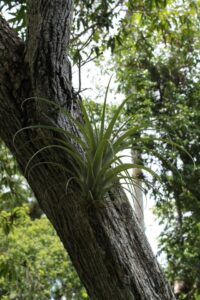 Air plants should ideally take up moisture from their surroundings. But if we’re being honest, our indoors are so regulated that the moisture balance is often off.
Air plants should ideally take up moisture from their surroundings. But if we’re being honest, our indoors are so regulated that the moisture balance is often off.
So, these plants need soaking/ dunking regularly to keep up with their activities. Else, they end up dehydrated and exhibit signs such as:
- Browning of the leaves,
- Curling, rolling, or wrinkling of the leaves,
- Drying and crisping of the leaves, and
- The development of pale leaf color.
These show that the plant does not have adequate hydration.
How Can You Deal with Underwatering?
Use the same steps outlined under overwatering and take note of your plant type. For example, if your plant is xeric, it needs less watering than a mesic plant.
3) Too Much Sun Exposure
Air plants burn easily when exposed to direct sunlight. And the only time you should ever leave them in such light is when trying to save them from overwatering.
Else, when you place them under the sun, the plants overheat and lose water to the environment, leaving them vulnerable to foliage damage. And soon enough, the plant shows signs of distress, including:
- Spotting on the leaves,
- Yellowing of the leaves,
- Crisping of the leaf tips or entire leaves, and
- The development of pale leaf color.
Have you seen such changes in your plant?
How To Deal with Too Much Lighting
I have good and bad news (I’ve always wanted to use this phrase). The bad news is that leaf damage owing to sun exposure is irreversible.
The damage is done – sigh. But the good news is that once you move your plant to a suitable location, it will not be at risk of more damage. Yay!
So, where should you move your plant? Air plants do well in bright and indirect light – what we sometimes call dappled or filtered light.
And you can find this in the west and east-facing rooms in your home. Ensure the plant is near but not against the windows so you can protect it from direct morning or afternoon sun rays.
If you choose to leave the plant in a south-facing room, add sheers to protect the leaves from the harsh light.
What should you do with the damaged leaves? The best approach is to cut them off. Else, the plant will focus on healing these damaged parts instead of using that energy on healthy growth.
Use a sharp, sterilized tool to get rid of them and allow the plant to thrive in its new space.
4) Too Little Sun Exposure
Air plants, while largely the same, still have some core differences. Xeric plants can do well in bright and direct light, while mesic types would die under such exposure.
Thus, it could be that you are giving your plant less light than it deserves. How can you tell if this is the case? Well, here are the sure signs:
- The plant starts losing color and appearing dull,
- The plant’s growth takes a hit,
- Leaves start falling off, and
- The plant starts withering as it dies.
Without light, your air plant cannot survive, let alone thrive.
Can You Fix Too Little Lighting?
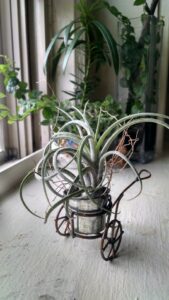 I think that this is one of the easiest problems you can ever face with an air plant – because the solution is simply to provide more light. It is that easy!
I think that this is one of the easiest problems you can ever face with an air plant – because the solution is simply to provide more light. It is that easy!
Air plants do well in bright and indirect light, like I stated, under too much sun exposure. Position your plant in a spot that receives such light, and it should be fine.
Please do so gradually to give it time to acclimate to the new conditions.
What if your natural lighting is not sufficient? In that case, you can invest in artificial lights to account for the difference. Leave the lights on for 12 hours and watch how the plant responds.
When the weather gets warmer, and the plant starts getting more natural light, you will need to adjust the timer accordingly.
5) Temperature Variations
When you leave your plant in direct sun, it dehydrates and starts curling. Leaving it in freezing temperatures is not good, either, as it can cause frost damage. Below are the warning signs that you may have left your plant in unfavorable conditions:
- Foliage damage – this can be due to the sun or frost,
- Root rot – this comes about when the plant gets little heat and thus cannot lose excess water through optimal plant processes,
- Leaf curling – this is a sign of dehydration due to too much heat.
This list is not exhaustive, but you get the idea.
Should You Regulate the Temperatures?
Oh, yes! We are all that air plants have to shield them from the elements, which can be pretty harsh at times.
And to do that, we must maintain their temperature range at 55 to 85 degrees Fahrenheit. If you go higher or lower than this, you know what follows.
6) Inadequate Air Circulation
Does your air plant have enough air moving around it? Not having enough airflow prevents the plant from drying out before its next watering schedule. And that is the gateway to root rot. You know that your plant needs more airflow if:
- Its leaves are browning,
- The plant appears to be dying, and
- The plant shows signs of root rot.
It’s entirely possible to mistake the cause of root rot to be overwatering, yet poor airflow is the issue.
Can You Fix Poor Air Circulation?
Sure! Leave the plant in a well-ventilated spot where it can access air drafts all day.
And if you have the plant in a container, ensure its mouth is wide enough to allow good ventilation. I’d advise you to mount or hang the plant, giving it better access to air.
7) Fertilization Issues
Does your plant have enough fertilizer? Or are you over or underfeeding it? Too much fertilizer causes root damage, which shows as:
- Drying leaves,
- Yellowing on the leaves, and
- Browning on the leaf surface.
An underfed air plant will show signs of wilting, dying, stunted growth, and pale leaves.
How to Prevent Fertilizer Issues
To avoid overfertilizing or under-fertilizing your plant, use an air plant fertilizer per the manufacturer’s instructions. And dilute it to ¼ of its strength. And only use the feed when the plant is actively growing.
You may also like: How big can an air plant get
8) Pest Infestation
Did you know that air plants can also get infested by plants? If none of the above possible problems pan out, your air plant could be battling pests.
And the most common culprits are scales and mealybugs. Look out for signs of infestation by using a magnifying glass to inspect the leaves.
If you find any pests, isolate the plant and either use homemade insecticidal soap or neem oil on the plant.
Final Thoughts
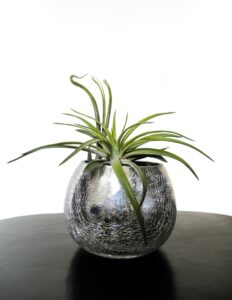 Some of the changes in your air plant will be normal. Take an example of where your plant turns red. If too much light exposure is not the cause, it’s a sign that your plant is happy.
Some of the changes in your air plant will be normal. Take an example of where your plant turns red. If too much light exposure is not the cause, it’s a sign that your plant is happy.
And it shows that you have given it what it needs to thrive and bloom, which is likely what it’s about to do. But most of the changes will point at a need you have not met.
Consider what could be killing your air plant by reviewing the plant care routine I outlined and nip the problems in the bud – or should I say in the pup?
Happy Gardening!

